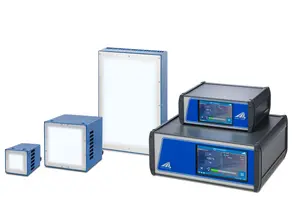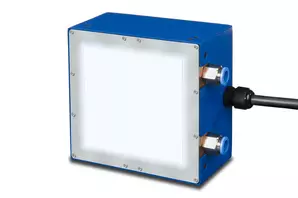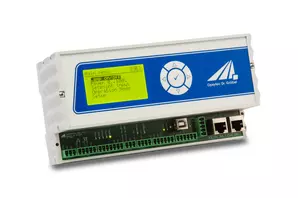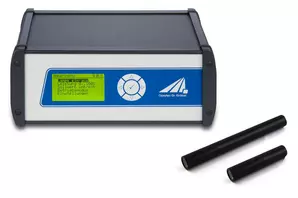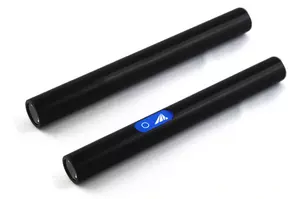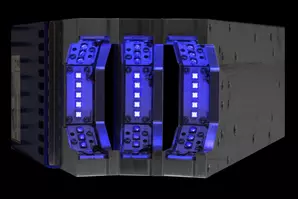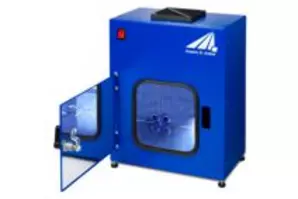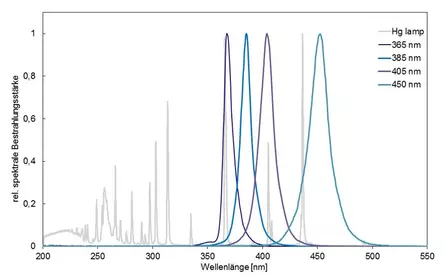Efficient UV LED light sources for industrial and scientific applications
The highly effective UV radiation without disturbing heat radiation is characteristic for our UV-LEDs. All UV-LED lamps are available in the wavelengths 365 nm, 385 nm, 395 nm, 405 nm and 450 nm.
If you are not yet able to define "your" wavelength, we will be happy to provide advice and support. Tests in your house are also possible in our LED irradiation chambers. Besides the high reproducibility, another advantage is the combination of two wavelengths.
For area applications we offer the air or water cooled UV-Leds Series L and SFL series with power ratings from 50 W to 6000 W.
For the control of the UV-LED area lamps we offer the LedControl S as a desktop device or the LedControl DC for a DIN rail mounting. The LEDControl DC is optimal for integration into a PLC and reaches a high performance level.
For bonding our compact LEDs Spot-P LEDcontrol and the cost-effective solo P are suitable.
Existing industrial systems can be converted to UV LEDs at low costs with our customized LED solutions.
UV-LED VS. UV LAMPS
In general, UV lamps allow for high process speeds with a very good productivity. The UV lamps, which are typically used in UV systems, feature an electrical power in the range of several hundred watts up to ca. 20 kW. The typically used Hg medium pressure lamps emit a discontinued line spectrum under high pressure conditions in the UV spectral range. The dominant emission is in the UVC spectral range. The efficiency is approx. 25% - 35% of the electrical power. With the utilization of doping, the emission can be moved to the long-wave UV (e.g. by means of iron lamps) or to the blue spectral range (ga lamps), but partly at the cost of the efficiency and service life of the lamp.
Thus, the utilization of UV light-emitting diodes (UV LEDs) in curing systems increases continuously. Benefits of the UV LEDs compared to the UV lamps are the
- highly efficient operation
- initial start
- dimmability to < 2 % of the nominal power
- long service life
- lower heat input
At this point, we would like to address the heat input by high quality UV LEDs in comparison to the UV lamps. On the surface of the material irradiances of several W/cm² are reached. In addition to the useable UV irradiance, there is a high infrared portion in the UV lamps. This is caused because the UV lamp emits a major part of the power dissipation through the plasma and the hot jacket. LEDs emit the power dissipation only in the form of heat conduction to the heat sink or the water cooling. It is therefore right to speak of a lower heat input. However, the irradiance is still in the range of the power density of a stove top (~ 3 – 4.5 W/cm²). Also due to this power, a considerable heating of the material is reached. It is therefore beneficial to avoid the additional heating by IR radiation. That is why we provide large area UV LEDs, with which the simultaneous radiation of the heat input and the process parameter can be optimized.
Up to the current state of the art, UV LEDS are primarily available in the spectral range > 365 nm, since their development is driven by high power LEDs in the visible spectral range. Here, the wave lengths of 365 nm (often referred to as black light), 385 nm, 395 nm and 405 nm are of technical relevance. Whereby, the LEDs with an emission above the wavelength of 400 nm are actually blue LEDs. So at this point it is important to mention the risk of a photochemical damage to the eye (“blue light hazard”). Due to this UV-LED chambers offer a flexible and safe use in laboratories and manual production.
The reached optical performances of UV light-emitting diodes of below 365 nm are merely a few mW. Due to the large choice of available wavelengths, these are still of interest for analytical purposes as our process photometer.


